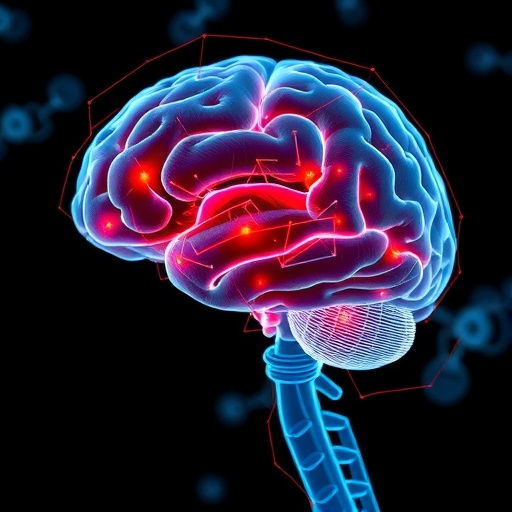Traumatic brain injury (TBI) remains a significant public health challenge, characterized by complex and multifaceted pathophysiological consequences that often lead to enduring neurological impairment. In recent years, scientists have made substantial strides toward innovative therapeutic strategies to address the aftermath of TBI. One particularly promising avenue of research involves the utilization of electrospun nanofiber scaffolds, specifically designed to deliver copper oxide (CuO) within the affected tissues. These scaffolds aim to restore copper homeostasis, an essential metabolic balance that is critical for neuronal health.
The innovation of incorporating copper oxide into electrospun nanofiber scaffolds represents a groundbreaking shift in treatment methodologies. The scaffolds, composed of biocompatible substances like polycaprolactone (PCL) and gelatin, are engineered using an advanced electrospinning technique. This process not only ensures an optimal structural design for the scaffolds but also allows for the sustained release of copper ions at controlled rates. The therapeutic significance of copper cannot be overstated, as it plays a pivotal role in numerous physiological processes, including antioxidant defense mechanisms and the regulation of inflammation.
Research findings indicate that the CuO-loaded scaffolds are particularly effective in mitigating the consequences associated with neuronal pyroptosis—a highly inflammatory form of programmed cell death triggered by TBI. Pyroptosis is especially detrimental because it exacerbates injury through inflammatory processes, further complicating recovery efforts. By utilizing electrospun polynucleotide-based scaffolds administering copper ions at the site of injury, researchers have reported a significant reduction in cellular death and a corresponding enhancement in overall brain health.
Animal studies have shown that the application of the scaffold approximately six hours post-injury yields the most beneficial results. The 0.5% CuO@PG scaffold formulation exhibited a marked decrease in the levels of pyroptosis-related proteins, such as NLRP3 and Caspase-1, effectively blunting the inflammatory response that ensues following TBI. This controlled intervention not only aids in decreasing cellular death but also facilitates the repair of damaged brain tissue—an essential factor when striving for optimal rehabilitation outcomes.
Moreover, these remarkable scaffolds have been systematically tested through behavioral assessments, including paradigms like the Morris Water Maze and the Wire-Grip Test. The scaffolds provided a consistent improvement in neurological functions, thereby highlighting the enhancement of motor and cognitive capabilities in subjects with traumatic brain injuries. Researchers observed that the incorporation of copper oxide scaffolds fosters an environment favorable for recovery by not only addressing direct cellular injuries but also promoting systemic healing.
In the pursuit of understanding the broader implications of copper therapy, it is essential to note that the innovative scaffolds may have applications extending beyond TBI. Copper’s integral roles in various neurodegenerative diseases mean that exploring its therapeutic potential could unveil groundbreaking treatments in the sphere of neurological health. The targeted delivery of copper through these scaffolds presents an opportunity to harness the metal’s beneficial properties while minimizing potential systemic toxicity—a significant advantage over traditional therapeutic approaches.
Dr. Yumei An, a lead researcher in this study, articulated the essential nature of copper in brain function and noted the potential this technology has to revolutionize treatment strategies for TBI. As the field of neurotherapeutics continues to evolve, the proposition of employing CuO-loaded scaffolds as a treatment mechanism underlines the value of interdisciplinary research that merges material science, molecular biology, and clinical medicine.
Despite the promising nature of the CuO@PG scaffolds, future investigations are pivotal for an in-depth understanding of optimal dosage and timing concerning scaffold implantation. Such explorations will undoubtedly refine therapeutic protocols, maximizing the scaffolds’ neuroprotective properties and enhancing recovery pathways in TBI patients. With a growing body of literature supporting the efficacy of copper in managing inflammation and cellular repair, researchers anticipate that future clinical translations will pave the way for advanced treatment modalities.
Lastly, while this innovative approach to TBI treatment displays immense potential, wider clinical applicability is contingent upon rigorous testing and validation through human trials. Ensuring the safety, efficacy, and accessibility of copper-based therapies is paramount as researchers work tirelessly to translate bench-side discoveries into practical, life-enhancing solutions for patients suffering from the debilitating effects of traumatic brain injuries. This research heralds a new dawn for TBI treatment and exemplifies the impact of scientific collaboration in advancing human health.
By merging cutting-edge materials science with biological insights, the future of TBI management is not only optimistic but also holds the promise of significantly improving the quality of life for countless individuals grappling with the repercussions of brain injury. As efforts continue to hone these advancements, the research community remains committed to unveiling targeted, efficient therapies that address the enduring challenges posed by traumatic brain injuries.
Subject of Research: Copper-Loaded Scaffolds for Traumatic Brain Injury Treatment
Article Title: Electrospun Nanofiber Scaffolds Loaded with Copper Oxide for Repairing Traumatic Brain Injury through Restoring Copper Homeostasis and Regulating Pyroptosis Pathway
News Publication Date: 9-May-2025
Web References: Burns & Trauma
References: DOI 10.1093/burnst/tkaf030
Image Credits: Credit: Burns & Trauma




